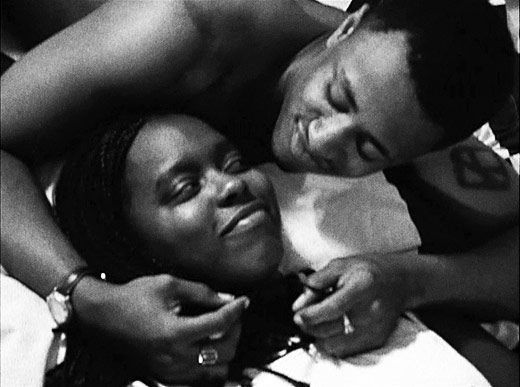
It’s definitely time for movies to tackle racial issues in depth, and the Chicago International Film Festival has provided the forum with two new important films. One will probably be a blockbuster, if it isn’t by the time you read this; the other, one hopes, will also get needed recognition, but they are both of extremely different quality.
The Evolution of Bert is a labor of love that took the director over 20 years to complete. Filmed on and off throughout the years using students from his Black Studies classes at Ohio University, and only when time and money were available, director Jeffrey Wray used 16 mm cameras to recreate the early look of black and white documentaries. Partly inspired by the filmed version of Amiri Baraka’s Dutchman, the often raw and low budget-looking film focuses on issues of racial identity and the racism still prevalent in contemporary American society. Content often trumps form when issues as urgent as these are addressed in a progressive manner. The film, begun in the ’80s, begins humorously with defining the four major stereotypical options available to Black men: the successful Black Republican (who ultimately sells out his people), the insurance salesman (a job security fallback), the working class stiff (destined to struggle for jobs), and the revolutionary activist (committed but doomed to economic insecurity). Obviously from personal experience, the director chose to play the role of the hip educated revolutionary, influenced by jazz, poetry and African American culture, who meets regularly in a coffeehouse influencing Bert, the first-year college student confronted with issues of racial identity and the desire to avoid falling into one of these predestined stereotypes. Bert struggles with women on campus, getting interested in school, and finding a suitable identity. Despite the loose and erratic editing and occasional student-level acting, the film addresses many of the same issues and is as relevant in current times as the next film discussed here, which came out with tremendous hype and thunderous promotion.
Dear White People is one of the most thought-provoking, intelligent and entertaining American films made on race and racial identity. It is hilarious, insightful (maybe even “inciteful”), and has such a dense screenplay that it will have to be viewed several times to catch everything. Bold and challenging, it has already been compared to Spike Lee’s films, especially Do the Right Thing and Malcolm X, and the classic campus comedy, Animal House. African American director Justin Simien, who also happens to be gay, held nothing back, confronting issues like racial identity, reverse racism, skin color and profiling, sexual orientation, Uncle Tom-ism, post-racial ideology, campus drugs, white fraternities, cultural differences – all within the social structure of the 2 percent Black students coping with survival on a majority-white, “racism doesn’t exist anymore” campus. Actually, the originally planned title was 2%, which refers to the real average percentage of African American students on U.S. campuses.
As in the previous film, the director clearly identifies with a specific character with similar experience and attributes, in this case, Lionel, a geeky gay Black student with a giant Afro who knows little about Black culture. Unaccepted by anyone on the Ivy League campus and unwilling to take any position on race, he is hired by the white campus newspaper to infiltrate the Black student groups, and somehow ultimately comes around to “leading the revolution” instigated by his experience at a shocking black-face fraternity party. It’s Sam, the radical DJ, host of the “inciteful” show “Dear White People,” who antagonizes the white students with statements like, “… the amount of black friends required not to seem racist has just been raised to two … and your drug dealer doesn’t count.”
Simien said he used a Twitter account to test the Dear White jokes used in the film, and then incorporated some of the Internet responses in his script. He said he had always intended the film to be a satirical multi-protagonist story (although he was told “you’re not Robert Altman, so don’t try!”) about identity with a Black lens, more so than racism per se. He wanted it as a call to action, and started funding through Kickstarter. Five years later the film, released ironically at a time when the Ferguson killing brought racism once again to the headlines, came to fruition.
The popular, handsome dorm president, Troy, son of an “Uncle Tom” associate dean, is a product of Black parents driven to have their child succeed by assimilating and dating white girls.
A mixed-race student, Samantha, known as DJ Sam, represents the militant Black nationalist who exposes racism in all its form and challenges students’ racial identity, with an acerbic wit and deadly sarcastic style in her “Dear White People” radio show. All combinations of race relations are fearlessly explored and developed, leading to unpredictable consequences.
The movie is about keeping it real and finding an authentic self. When asked what it means to do this, director Simien responds, “It’s such a double-edged sword. You have to decide who is defining ‘real.’ As a Black person where, in the world my identity is often decided for me before I walk into the room, ”real’ is a marketing ploy used by, often times, white executives to sell me a product. For example, ‘real’ is the top hip hop on the Billboard charts, it’s the right shoes, the McRib sandwich.” He suggests that “what it means to be real is to be your authentic self, and whatever your identity is out in the world is related to who you really are. And that can be really, really tough. It’s hard to be yourself in most situations. Too many of us are being fake trying to be real.”
The director answered astutely when asked about his “target audience.” Simien replied, “I prefer not answering that question because it always sounds like a marketing ploy. It can be confused with the intended audience for the message, which of course would be everyone, as opposed to the audience who will buy the film.”
The many messages in both of these films need to be experienced by a large audience. It was pointed out at both screenings that racism today is manifested in different forms, not as overt as in the past. It might be that the anti-racism struggle is at a higher level, and that success has come to many more African Americans than in the past, but this creates the illusion that racism has been conquered or eliminated. When considering percentages of Blacks in prison, mortality rates, salaries, unemployment rates and almost every other social indicator, whites always fare better. These inequalities need to be addressed urgently, and destroying affirmative action, public assistance and other programs because we are supposedly in a “post-racial” society is delusional.
Although these films don’t directly address the current realities of mass Black incarceration, rising school tuitions, or the persistent economic and social inequalities between races, they do provide an important forum for thought and action presented in an extremely entertaining and provocative manner. These films also avoid a class analysis, focusing primarily on a privileged class of Ivy League students dealing with race. But the directors are quick to say they don’t intend to provide any answers or solutions: It’s up to viewers, based on their own realities, to decide what to do. One suggestion is to go out immediately and see Dear White People (Evolution of Bert will be harder to find), one of the freshest and most satisfying cinematic experiences dealing with the critical issue of race.
Photo: Bert romances Nita. Facebook.










